
When it comes to interval training, just about everyone out there has an opinion on the best way to do them.
What most people agree on, however, is that key to getting the most out of interval training is intensity – it’s usually called high-intensity interval training (HIIT), after all.
But is this the only way intervals can, or should be done?
Do you really need to Tabata yourself into the ground all the time to get leaner, better conditioned or improve your fitness in record time?
My answer: no.
In fact, I want to walk you through (and show you a video) of exactly how I use a much different type of interval. One that’s purposefully done at lower intensities and not designed to make you feel like you’re dying every time you do them.
The whole goal of doing this type of interval is the exact opposite actually: to help you feel better and recover faster.
Introducing The Tempo Interval: A Better Way to Boost Your Recovery

Despite the fact that very few people know about them, Tempo Intervals have been around a long time. They were originally popularized in the track and field world by a coach named Charlie Francis.
The ironic thing is that almost everyone has heard of a Tabata interval, even though Tabata is a random scientist in Japan that nobody has ever even seen a picture of. Charlie Francis, on the other hand, coached one of the best sprinters of all time and was a highly respected track coach with decades of experience.
So, why would a track coach training some of the fastest athletes on the planet use a relatively low speed, low-intensity interval on a weekly basis with all of his sprinters?
Simple: Charlie used them for an entirely different purpose than most.
He wasn’t using Tempo Intervals to increase speed, he was using them to increase recovery.
As you can imagine, sprinting at speeds that only a few humans on earth will ever hit is both incredibly demanding and fatiguing. Charlie felt that Tempo Intervals were absolutely vital to help his athletes recover faster in between training sessions.
Personally, I first heard about Tempo Intervals from Charlie himself all the way back in 2002 at a workshop he put on up in Vancouver. After hearing him walk through the science and asking him some questions on the specifics, I decided to give them a try with myself and my athletes as well…
From the start, I recognized just how effective they were not just at speeding up recovery, but at improving results.
At the time, I had just started using heart rate variability (HRV) technology to directly measure recovery and changes in fitness. The data confirmed exactly what Charlie said: they worked.
Once I started introducing them into pretty much every training program I wrote, people consistently reported things like:
- Feeling less tired and sore after a workout
- Being able to train at higher volumes without overtraining
- Decreased rates of lower body injuries
- Reduced soreness and improved mobility
Over the years, Tempo Intervals have been one of my favorite go-to conditioning methods. It’s pretty rare that I don’t include them in someone’s program simply because they’re so versatile and effective at what they were designed for.
How do you do a Tempo Interval?
The basics of a Tempo Interval are to do 10 seconds of work at a moderate intensity, followed by 60 seconds of active recovery.
The key to doing them properly is the intensity and this is where most people get them wrong. Too much intensity, and they can actually slow down recovery.
Too little intensity, on the other hand, and they just aren’t effective.
Even more challenging, what may be moderate intensity for you on one day when you’re well recovered, may be too high on another day when you’re not.
So, how do you know what the exact right Tempo Interval intensity is each day?
Well, for many years I was forced to use my instincts to simple guesstimate what that intensity was. If someone was using BioForce HRV, this certainly made things easier, but I was still just making a bit more educated guess than anything else.
Now, I simply use Morpheus, to help pinpoint this moving target. In fact, this is really one of the key reasons I developed him in the first place: to help people not just guess, but know what the right amount of intensity is each day.
Let me walk you through how this works exactly…
Step One: Get your recovery score
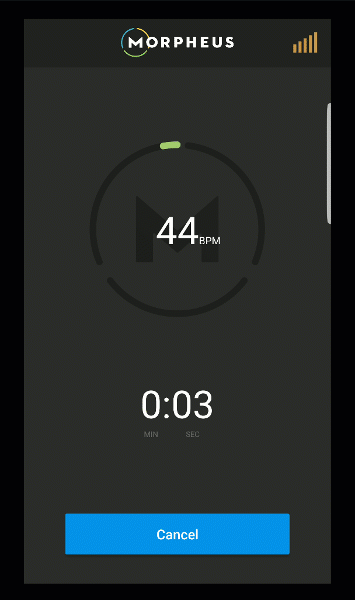 The first place to start pinpointing right intensity for the day is to take the 3-minute recovery test using the Morpheus recovery band.
The first place to start pinpointing right intensity for the day is to take the 3-minute recovery test using the Morpheus recovery band.
The test is about as easy as it gets. All you have to do is put on the band (it’s designed to comfortably fit on your forearm or calf), then hit “Start” and j sit back and relax for a couple of minutes while Morpheus measures your heart rate variability.
From there, Morpheus will crunch all the numbers. He takes a look at your HRV, your sleep, how hard you’ve been training, how active you’ve been, and how you feel. He uses all this information and uses sophisticated machine learning algorithms to figure out exactly what your own recovery score is.
Take a look at the video to see exactly what this looks like.
Step Two: See your personalized training zones
Based on your individual recovery score, Morpheus will then give you three personalized training zones for the day. Each of these zones has a different purpose and a different color.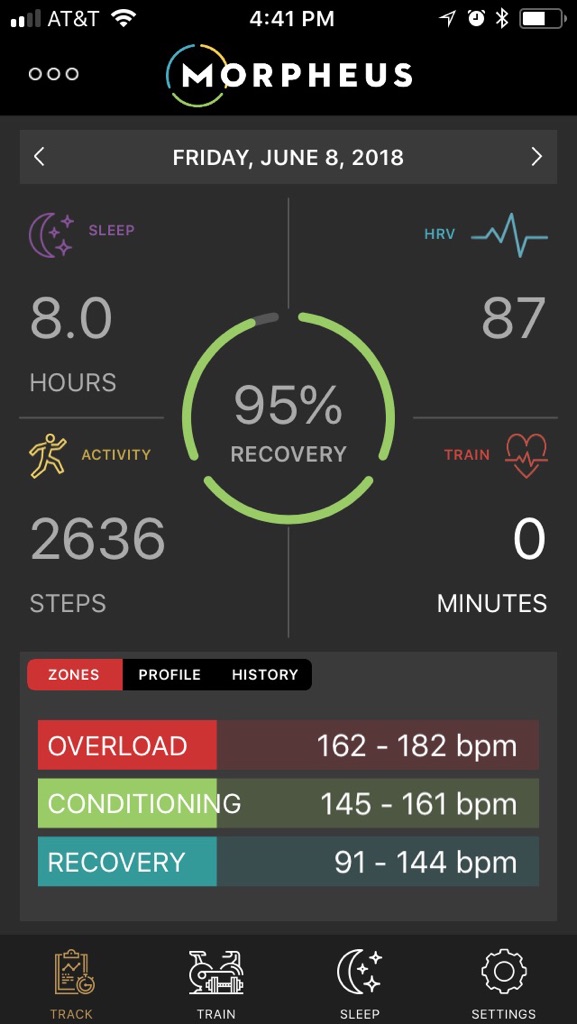
As you can see in the screenshot, there’s a blue zone for Recovery, a green zone for Conditioning and a red, zone that’s a max intensity, or Overload zone.
For Tempo Intervals, you’ll want to keep your heart rates primarily in the recovery zone. This is the exact right intensity that will help shift you into the recovery state.
This where more energy will be directed towards rebuilding your body to be stronger, faster, fitter and better conditioned. Remember, these zones will be different each day as your recovery score changes.
This is the key to getting the most out of each and every workout.
Step Three: Get to work
The best way to show you exactly how to do Tempo Intervals using Morpheus is to show you myself. I pulled this video from my online BioForce Conditioning Certification to help you see precisely how to do them and exactly what to look for.
Step Four: Watch your recovery increase and your results improve
One of the features we’ve heard Morpheus users say they love the most is the ability to see how their workout impacted their recovery. By analyzing how much time you spent in each of the training zones, the total time you trained for and your RPE, Morpheus can show you whether your recovery increased or decreased as a result.
This helps you gauge the overall effectiveness of your training and fine-tune your program over time. When using Tempo Intervals as part of the Rebound Workouts I’ve talked about, the goal should be to see an increase in your recovery score immediately following the workout.
This means you got things right and your body is shifting into the recovery state. I generally suggest aiming for a 3-5% increase in recovery. You can see in the example of how this works by taking a look at the training results below and change in recovery below.
How often should you do Tempo Intervals?
How often you should do Tempo Intervals depends on how much you need to do them based on your recovery each day and your program. I typically have people I’m working with incorporate 1-2 Rebound Training workouts per week and I almost always include at least a few Tempo Intervals.
It’s also most important to do this type of training whenever Morpheus shows your recovery score dropping below 80%. This is what will help you prevent you from developing a recovery debt and sabotaging your results.
Anywhere from 10-20 minutes of Tempo Intervals usually does the trick and will help bring your recovery score back up.
What exercise should you use?
One of the great things about doing Tempo Intervals using Morpheus is that you can do just about any exercise you want.
As long as you use the right training zone, you can do anything from running, to battle ropes, to medicine ball throws and just about anything in between. The most important thing is the intensity – as long as you’re using Morpheus to get that right, the exercise is up to you.
Do they really work?
If Tempo Intervals didn’t work, I wouldn’t be doing them myself and using them with pretty much everyone I’ve trained since 2002. So yes, they work and they work extremely well… but only as long as you do them correctly.
More is not better.
Using Morpheus makes it easier than ever to use not just Tempo Intervals, but recovery-based training in general as a way to accelerate your results. You can see from some comments we’ve gotten on our Facebook page from happy Morpheus users the type of changes they’ve seen since fine-tuning their intensity and upping their recovery game.
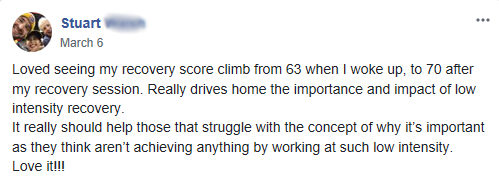


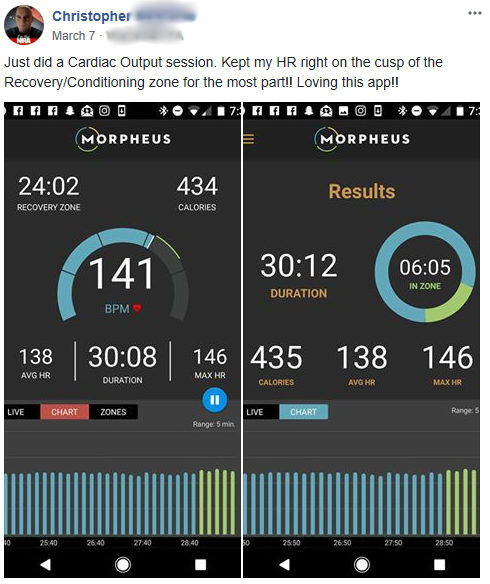
How can I get Morpheus and start doing Tempo Intervals in my own training?
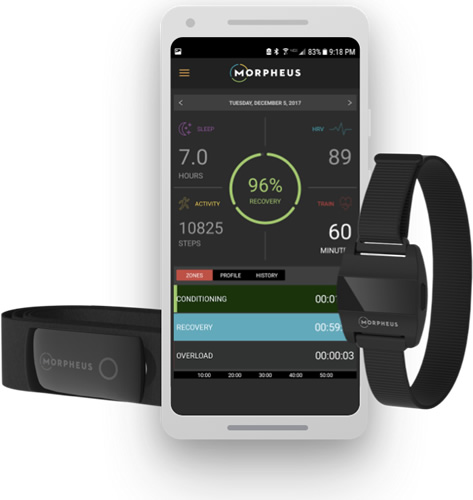 If you’re ready to add smarter interval training into your program and start getting more out of every workout, you can get Morpheus by clicking here.
If you’re ready to add smarter interval training into your program and start getting more out of every workout, you can get Morpheus by clicking here.
Morpheus comes with the M5 HRV band and the M7 chest strap for the highest level of accuracy in every workout.
You’ll also get access to the Morpheus Academy and courses to teach you all about interval training, HRV, recovery, sleep, and more.
Train smarter and recover faster with Morpheus.

